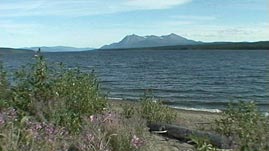Teachers' Domain - Digital Media for the Classroom and Professional Development
User: Preview

Source: Yukon River Panel
In this video segment adapted from the Yukon River Panel, explore the role of salmon in Alaska Native cultures and the efforts to help maintain healthy salmon stocks. Learn about the Yukon and Teslin River programs that regulate the harvest of salmon to keep stocks at healthy levels. Listen as subsistence users share stories about their experiences with salmon and discuss the changes they have seen in salmon stocks. See how one research team collects data to study salmon and freshwater productivity. Hear about concerns for future generations and the importance of stewarding this important fish stock.
People who follow a subsistence way of life harvest wild foods from the land and sea. Subsistence is a traditional way of life that has been around for thousands of years and provides more than food, shelter, and materials—it is a central part of Alaska Native culture. For many Alaska Native communities, fish serves as the basis for the subsistence diet. However, fish are also harvested for commercial, sport, and personal use. In addition, many species of fish are sensitive to environmental changes. In order to preserve fish stocks and the subsistence way of life, it is necessary to exercise wise stewardship.
Salmon anchors the subsistence diet for many communities in Alaska. The commercial salmon harvest averages more than 100 million fish per year and is a significant part of Alaska's economy. With both cultural and economic dependencies on salmon, it is important that the health and population of salmon stocks are closely monitored. Their conservation is required under Alaska law, and management plans give top priority to subsistence fishing.
Salmon are harvested when they return from the ocean to the rivers, streams, and lakes to reproduce. They breed in fresh water and then the next generation migrates to the ocean as juveniles, where they mature for several years. Adult salmon then return to the same fresh water where they were born to spawn. Salmon are thus affected by human activities and environmental conditions in both ocean and stream environments; they are susceptible to water conditions (such as stream flow, water temperature, and pollution), interception by factory trawlers, and habitat destruction. Some salmon travel hundreds or thousands of miles upriver to spawn. For Alaska Native communities that live farther inland, their salmon harvest is affected by the conditions along the entire length of the run.
Most commercial fishing occurs at the mouths of the rivers; it is therefore important to make sure that enough fish make it past commercial fishery areas to reach the rural villages upriver. However, the goal of a successful management program is to maintain the long-term health of salmon stocks. Fishery managers need to allow enough fish to escape capture in order to sustain the population. Management programs open and close fisheries based on abundance counts to ensure the escapement. Researchers also study the fish to learn more about them and better understand how environmental conditions affect their survival and breeding success. A more complete understanding of salmon and their ecosystems will further improve conservation and management programs. Researchers may take measurements (such as length, weight, sex, condition), monitor the salmon to estimate survival rates, analyze habitat changes, look for patterns in spawning locations, and study water quality.
Commercial overfishing is not the only threat to salmon stocks. Increasing temperatures in rivers, decreasing water levels, and proliferating beaver dams resulting from climate change may also have adverse effects on salmon populations. Warmer waters may increase the likelihood of parasite infection, which together with pollution are making the fish inappropriate for eating. Growing numbers of sport fishermen, fly-in fishing businesses, and fishing lodges in rural areas may also deplete stocks unless they are more carefully controlled.
 Loading Standards
Loading Standards Teachers' Domain is proud to be a Pathways portal to the National Science Digital Library.
Teachers' Domain is proud to be a Pathways portal to the National Science Digital Library.
